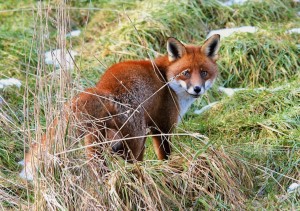 With the forecast of snow there is always the temptation to batten down the hatches and stay indoors but in the right conditions snow can be very revealing. It can tell you more about the local mammals, anywhere in the Highlands, than weeks, even months, at other times of the year. The main consideration is when the snow falls and how deep it is and in fact the right conditions normally only occur once or twice each winter With this is mind if the conditions are right then drop everything else and make the effort to get out there. Ideally the snow should fall just as it is getting dark and remain there until daylight the next day. The amount should be between one and a half inches and two inches. Less than that and any wind will leave blank areas where tracks will not register and more than two inches means tracks are obscure and you cannot make out the markings clearly.
With the forecast of snow there is always the temptation to batten down the hatches and stay indoors but in the right conditions snow can be very revealing. It can tell you more about the local mammals, anywhere in the Highlands, than weeks, even months, at other times of the year. The main consideration is when the snow falls and how deep it is and in fact the right conditions normally only occur once or twice each winter With this is mind if the conditions are right then drop everything else and make the effort to get out there. Ideally the snow should fall just as it is getting dark and remain there until daylight the next day. The amount should be between one and a half inches and two inches. Less than that and any wind will leave blank areas where tracks will not register and more than two inches means tracks are obscure and you cannot make out the markings clearly.
What puts some people off is that they do not know how to identify tracks. One way forward is to start to look at mammal tracks that you know such as the family dog or cat. In the winter there are lots of small bare areas of soil or sand where tracks register and this happens across the countryside. So if you know of a rabbit warren then look around it. If you are fortunate to know of a badger sett then more often than not their tracks will register in the huge spoil heaps at the entrance to each sett. If you see a hare then mark where it goes through a fence as if it is a regular run there could well be bare earth where their tracks register. The other way forward is to look at books and a quick glance at my bookshelves and it is obvious that there is no single book on tracks. One of the most useful ones is the Collins “Animal Tracks and Signs” and part of this book is devoted to tracks. Another Collins book is “Mammals of Britain and Europe” with tracks included but the trouble with both these books is that it covers Europe. They include a number of mammals that we do not get in the Highlands such as brown bear and wolf although these days with silly ideas on introductions you can never be sure. This is no problem with a book in the series by Reader’s Digest entitled “Field Guide to the Animals of Britain” first published in 1984 and reprinted a couple of years ago. There are seven pages devoted to tracks. Perhaps the best book on my shelves is the pocket guide published by Oxford University Press in 2001 entitled “Animal Tracks and Signs” although once again it deals with Europe. There are 70 pages devoted to what it terms “footprints“.
The next move forward is to decide where to look and one might just as well say anywhere although some places are obviously better than others. If I had to make a single choice I would go for deciduous woodland where there are rides and glades. The reason for the open areas being important is that the snow may well have not settled all over the woodland depending on the density of the trees. The first thing that will hit you is the sheer numbers of tracks and it comes as a great surprise to know just how many mammals of different species have been moving around during the night. One of the reasons for choosing woodland is that a number of mammals from deer to foxes resort to this habitat as it provides shelter and food even in bad weather.
